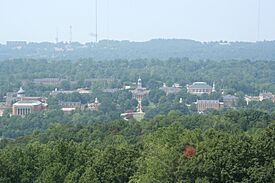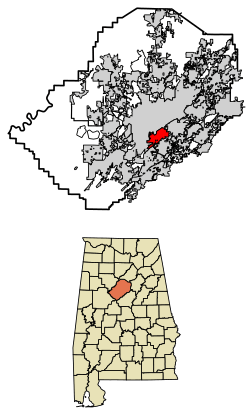Homewood, Alabama facts for kids
Quick facts for kids
Homewood, Alabama
|
|
|---|---|

Samford University
|
|

Location of Homewood in Jefferson County, Alabama
|
|
| Country | United States |
| State | Alabama |
| County | Jefferson |
| Incorporated | December 29, 1926 |
| Government | |
| • Type | Mayor–council |
| Area | |
| • Total | 8.31 sq mi (21.53 km2) |
| • Land | 8.26 sq mi (21.40 km2) |
| • Water | 0.05 sq mi (0.13 km2) |
| Elevation | 705 ft (215 m) |
| Population
(2020)
|
|
| • Total | 26,414 |
| • Estimate
(2022)
|
27,864 |
| • Density | 3,370/sq mi (1,302/km2) |
| Time zone | UTC−6 (Central (CST)) |
| • Summer (DST) | UTC−5 (CDT) |
| ZIP Codes |
35209, 35219, 35259
|
| Area code(s) | 205 and 659 |
| FIPS code | 01-35800 |
| GNIS feature ID | 2404724 |
Homewood is a city in Jefferson County, Alabama, in the United States. It's a suburb of Birmingham. Homewood is located just south of Birmingham, across Red Mountain. In 2020, about 26,414 people lived there.
Contents
Homewood's History
Homewood has an interesting past, starting from its early days as small communities to becoming the city it is today.
Early Settlements and Growth
The first people settled in the Homewood area around the year 1800. However, the population didn't grow much until 1873. At that time, a serious health problem affected Birmingham. Many people moved out of the city to find safer places to live.
They bought land and started new communities in the areas around Birmingham. Some of these smaller communities, like Rosedale, Grove Park, Edgewood, and Oak Grove, later became part of Homewood.
Edgewood grew the most. By 1911, it had an electric railway that went to downtown Birmingham. In 1915, a man-made lake was built there. This lake was created by building a dam along Shades Creek. Roads were planned around the lake for a race track, but this idea never happened. These roads are now called Lakeshore Drive and South Lakeshore Drive.
Becoming a City: Homewood's Incorporation
On December 29, 1926, a local lawyer named Charles Rice started a plan to combine several communities near Birmingham. In September of that year, Rosedale, Edgewood, and Grove Park voted to join together. They chose the name Homewood for their new city.
Later, in 1929, the city of Hollywood, Alabama, also became part of Homewood. Then, in 1955, Oak Grove joined Homewood as well.
Homewood During Tough Times
The Great Depression, which started in 1929, caused economic problems for Homewood. Around the same time, a health challenge affected many children in the city.
However, the area's economy began to get better when World War II started. Birmingham's steel industry grew a lot to help with the war effort. This growth helped Homewood too, and its population increased by 74% between 1940 and 1950.
Changes and Growth in the 1960s
In 1959, Homewood residents voted against Birmingham trying to make Homewood part of its city. Another attempt to join Homewood to Birmingham happened in 1964, but it was later canceled by the Alabama Supreme Court. In a special vote in 1966, Homewood residents again voted against joining Birmingham.
Homewood mostly avoided the major problems of the Civil Rights Movement in the 1960s. However, a local newspaper reported a bombing in Rosedale in September 1963.
In 1970, Homewood started its own school system, separate from the Jefferson County system. The new Homewood High School opened in December 1972.
Hollywood: A Unique Part of Homewood
Hollywood was once a separate town that became part of Homewood in 1929. Much of this area is now a historic district called the Hollywood Historic District. It's famous for its beautiful buildings designed in the Mission Revival and Spanish Colonial Revival styles.
Clyde Nelson started developing Hollywood Boulevard as a neighborhood in 1926. He wanted to attract people from Birmingham to move "Out of the Smoke Zone, Into the Ozone" over Red Mountain. Architect George P. Turner designed many homes in the Spanish Colonial Revival style. This style was popular because it was linked to the glamour of Hollywood, California, where movies were becoming famous. Turner also used the English Tudor style, which was already common in Birmingham.
The Hollywood Country Club (which burned down in 1984) and the American Legion Post 134 (originally Hollywood's Town Hall) were also built then. To support his new development, Nelson created the area's first bus line and brought natural gas to Shades Valley.
Hollywood officially became a town on January 14, 1927. Clarence Lloyd was its first and only mayor. The town joined Homewood on October 14, 1929. The Great Depression almost stopped all new building in the area.
In 2002, the Hollywood Historic District was added to the National Register of Historic Places. It includes 412 important buildings and one historic site, covering a large area.
Homewood's Geography
Homewood is located at 33°28′6″N 86°48′29″W / 33.46833°N 86.80806°W. The city covers about 8.31 square miles (21.53 square kilometers) of land.
Like the rest of Jefferson County, Homewood sits on top of deposits of iron, coal, and limestone.
Shades Creek, which is part of the Cahaba River system, flows through Homewood.
Homewood's Population
| Historical population | |||
|---|---|---|---|
| Census | Pop. | %± | |
| 1930 | 6,103 | — | |
| 1940 | 7,397 | 21.2% | |
| 1950 | 12,866 | 73.9% | |
| 1960 | 20,289 | 57.7% | |
| 1970 | 21,137 | 4.2% | |
| 1980 | 21,412 | 1.3% | |
| 1990 | 22,922 | 7.1% | |
| 2000 | 25,043 | 9.3% | |
| 2010 | 25,167 | 0.5% | |
| 2020 | 26,414 | 5.0% | |
| 2022 (est.) | 27,864 | 10.7% | |
| U.S. Decennial Census 2020 Census |
|||
In 2020, Homewood had 26,414 people living in the city. There were 9,770 households and 5,966 families. The city had about 3,191.6 people per square mile.
Who Lives in Homewood?
| Race | Number | Percent |
|---|---|---|
| White (non-Hispanic) | 18,178 | 68.82% |
| Black or African American (non-Hispanic) | 5,223 | 19.77% |
| Native American | 29 | 0.11% |
| Asian | 715 | 2.71% |
| Pacific Islander | 8 | 0.03% |
| Other/Mixed | 832 | 3.15% |
| Hispanic or Latino | 1,429 | 5.41% |
The 2020 census showed that Homewood is a diverse city. Most residents are White, followed by Black or African American. There are also Asian, Native American, Pacific Islander, and people of mixed races living in Homewood. About 5.41% of the population is Hispanic or Latino.
Schools in Homewood
Homewood has its own school system, which includes several schools for different age groups.
Public Schools
The Homewood City School System has five schools:
- Shades Cahaba Elementary School
- Edgewood Elementary School
- Hall Kent Elementary School
- Homewood Middle School
- Homewood High School
Colleges and Universities
- Samford University is a university located in Homewood.
Parks and Recreation
Homewood has several parks where people can enjoy outdoor activities.
- Patriot Park
- Homewood Central Park
- West Homewood Park
- Woodland Park
- Overton Park
- Spring Park
- Homewood Soccer Park
Transportation
Bus service in Homewood is provided by the Birmingham-Jefferson County Transit Authority, known as Max Transit.
Notable People from Homewood
Many interesting people have connections to Homewood.
- Ameer Abdullah, a professional American football player
- Mary Anderson, an actress
- Paul DeMarco, a lawyer and former state representative
- Aaron Ernest, a sprinter
- Katy Freels, a professional soccer player
- Charles Ghigna, a children's author
- Evan Mathis, a former American football player
- Ronald Nored, a basketball coach
- Eric Ramsey, a former American football player
- Samantha Shaw, a former State Auditor of Alabama
- Luther Strange, a U.S. Senator
- William C. Thompson, a judge
See also
 In Spanish: Homewood (Alabama) para niños
In Spanish: Homewood (Alabama) para niños

